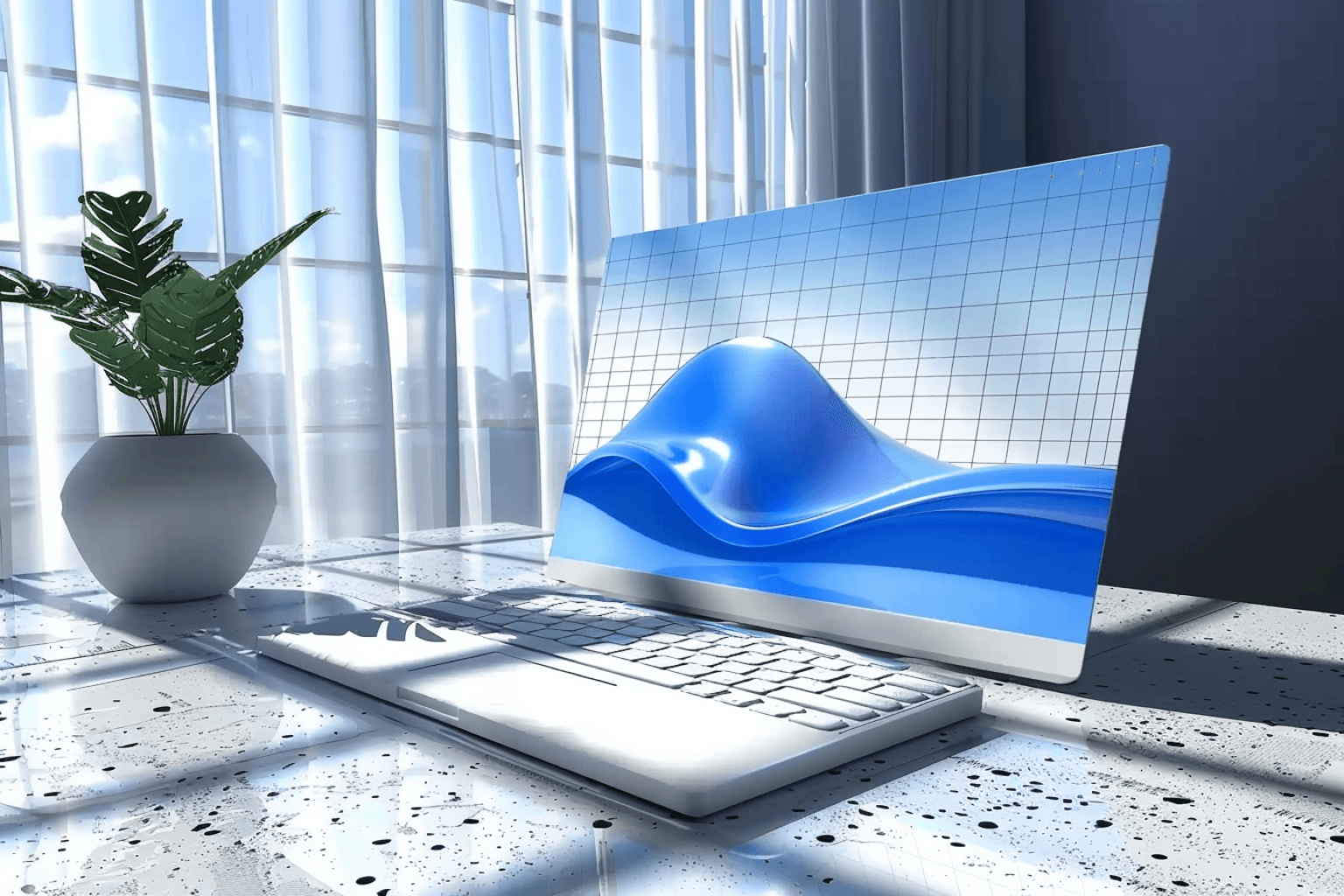The probability of selling to an existing customer is 60-70%, where the probability of selling to a new customer is just 5-20%. That’s a big difference, and yet only 19% of businesses focus on customer retention.
Part of retention is taking steps to actively re-engage inactive customers. In this guide, you’ll learn about the role win-back email campaigns can play and how to set one up.
What is a win-back email campaign?
A win-back email campaign is a sequence of emails sent to unengaged or inactive subscribers or customers with the goal of re-engaging them. Email content can include information on your product or service, engaging and educational content, customer testimonials, and offers or discounts.
Why do customers shift from active to inactive?
Customs can stop engaging with your business for a whole variety of reasons, including:
Change in interests: their purchase was based on a seasonal trend.
Dissatisfaction: they were unhappy with your service or products.
Flash sale purchase: they only bought because the products and services were discounted.
One-time or short-term purchase: their needs have since been met or they no longer require your product or services.
Cluttered inboxes: they have cluttered inboxes so are not receiving your emails.
Competition: Another brand with similar products or services could be top of mind because of marketing efforts or new/improved products
Holes in your product or service: It could be that your customer was interested in one thing your business does, but is lacking a feature, service, or product they need to make the investment worthwhile
A win-back campaign can address these reasons either directly (in cases where you have data to support why the customer is inactive) or indirectly (in cases where a reason is not supplied). Once you’ve addressed this, you’ll be able to make a data-driven decision about which customers come back, which are engaged with your content and worth keeping as subscribers, and which to sunset.
When should you send a win-back email?
Like any nudge or drip campaign, the entry point for the journey is as important as the email content itself. For a win-back email campaign, you will need to decide which criteria render a subscriber or customer inactive.
This will be largely dependent on your business model and sales cycle (a B2B sales cycle, for example, is far longer than a B2C sales cycle), but the following guidelines are a good place to start:
3 - 6 months of inactivity: Winnable, but at risk.
6 - 9 months of inactivity: Potentially winnable. Half as likely to re-engage as the group above.
9 - 12 months of inactivity: Unlikely to be re-engaged.
Based on this, your entry criteria could be any customer or subscriber who has not engaged with your brand (in other words, has not opened your campaigns, signed up for or purchased a product, or engaged with your sales or support team) for 90 days or more.
Exit criteria can be based on the next tier. If someone in the journey has not engaged with three of the emails in your win-back sequence they should be exited from the journey and sent a feedback survey and/or sunset.
Why should you re-engage inactive customers?
Here are six reasons you should prioritize winning back inactive customers over acquiring new ones:
1. Acquisition is increasingly expensive
Customer acquisition costs are skyrocketing, especially when it comes to pay-per-click (PPC) campaigns. To keep acquisition numbers growing, businesses must keep running these programs and continually inject more money into them.
To balance the rising cost of acquisition, it is crucial to reduce churn and increase your customer lifetime value (CLV). Win-back email campaigns will aid in customer retention and ultimately contribute to an increased CLV to reduce your CAC overtime.
And remember — that customer you win back could go on to become an advocate who shares your product or service with their network, increasing their worth further.
2. They are acquainted with your brand
Brand awareness happens the moment a person sees your logo and interacts with your business either through your website, social media platforms or directly visiting your store. But it takes more than that for a brand to leave a mental tattoo.
Your inactive customers are already familiar with your brand and product offering, meaning they've likely been exposed to your brand multiple times before.
For this reason, there’s no need for you to implement lengthy awareness campaigns or comprehensive brand introductions, you can assume they already know your value proposition, and winning them back might just take an extra nudge.
3. They already trust you
Customers don’t randomly purchase products from anywhere. In fact,81% of customers need to trust a brand before buying from it.
Until a prospect becomes a paying customer, they are unlikely to trust your brand. As they flow through the marketing funnel, trust is strengthened and, once they become a customer, their positive experience will reinforce that trust and influence their buying behaviors and loyalty to your brand.
4. They have an established need for your business
Unlike new visitors, inactive customers have already demonstrated a need or desire for your products or services. If this wasn’t the case, they wouldn’t have made the purchase.
Unless their circumstances have dramatically changed, they’re still your ideal target audience, meaning you don’t need to spend a lot of resources validating a net new audience.
5. You already have existing data on these customers
You already know who your inactive customers are, which products or features they’ve interacted with, the content they’ve engaged with, and so much more. You also know their lifetime value, engagement rates, and whether they’ve made any complaints.
This means that you can effectively personalize your win-back email campaigns.
Study all the behavioral data your marketing automation and CDP have on these customers — and use that information to win them back.
6. They can help you generate feedback
For your business to grow and reach its full potential, you need to identify its flaws and improve on them. Your inactive customers already had a one-on-one experience with you and could help pinpoint areas for improvement.
This could be your customer care services, product experience, or pricing. Using email, pop-ups, or SMS to send out a feedback survey will help you generate insights that can improve your brand and product to improve customer retention. And when you do take their feedback on board and improve your product or service as a result, you have another reason to reach out to your inactive customers and try to reengage them.
How to win back inactive customers (+ examples)
It’s likely your inactive subscriber or lapsed customer has been in your nurture flow or received your newsletter and the content, for whatever reason, simply didn’t win them over. So first you need to prioritize creating net-new content with different messaging to see what resonates.
Here are some examples of win-back emails that may be relevant depending on what they’ve received already and the data you have available:
1. Let them know what’s changed
It’s been 90 days since your customer or subscriber engaged with your brand, so it’s likely they’ve missed a few updates, some of which might make the investment in your product or service worthwhile.
As we mentioned above, if an inactive customer supplied feedback that led to a change in your product or service, this could be worth a more direct, personalized update to win them back. This email from Avocode, with the subject line, ‘Was Avocode too slow for you?’ is a great example of how it’s done.
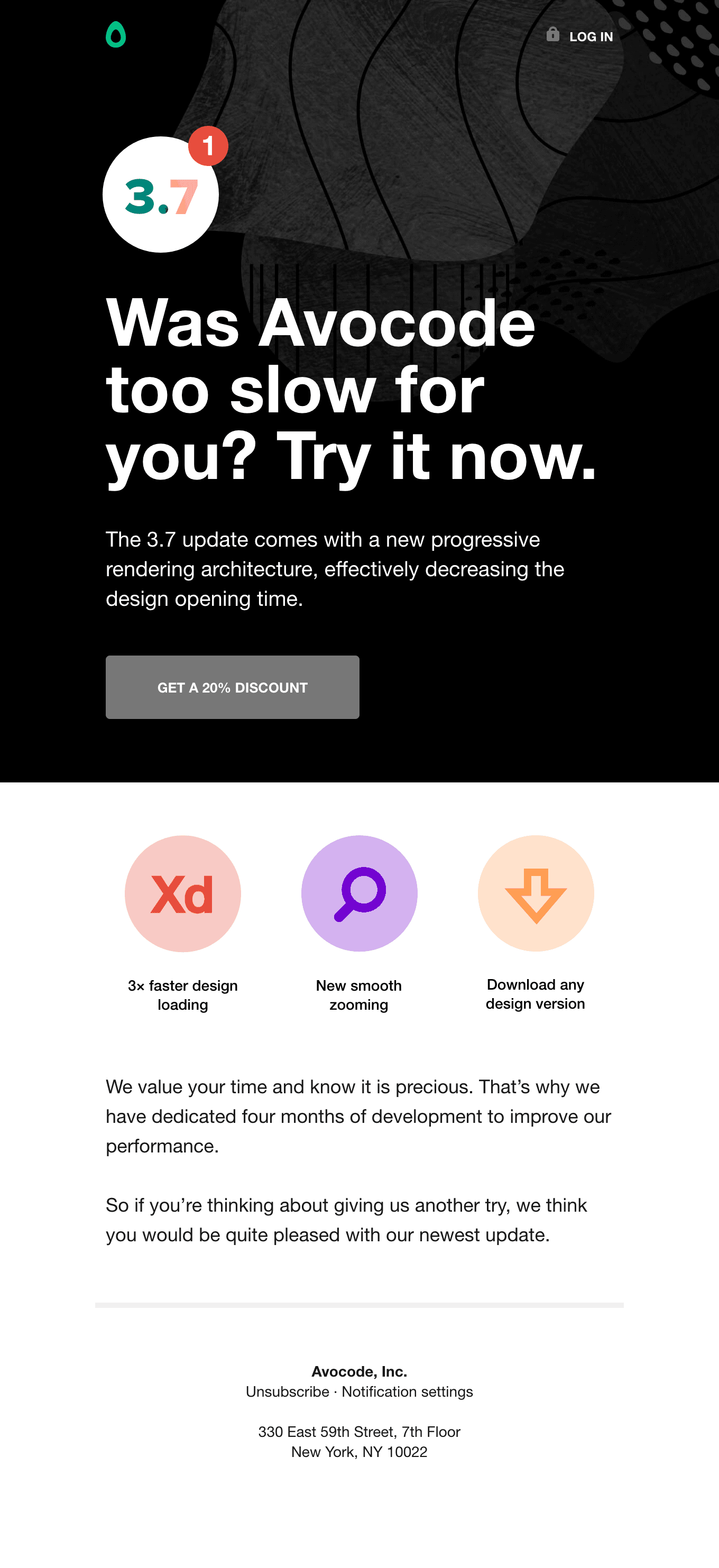
Source: Really Good Emails
Otherwise, a general update email including new features, improvements, updates based on customer feedback, and new resources can be a great place to start your win-back campaign. You can also include an offer to entice them, just like AI-powered creative studio Captions did in the example below.
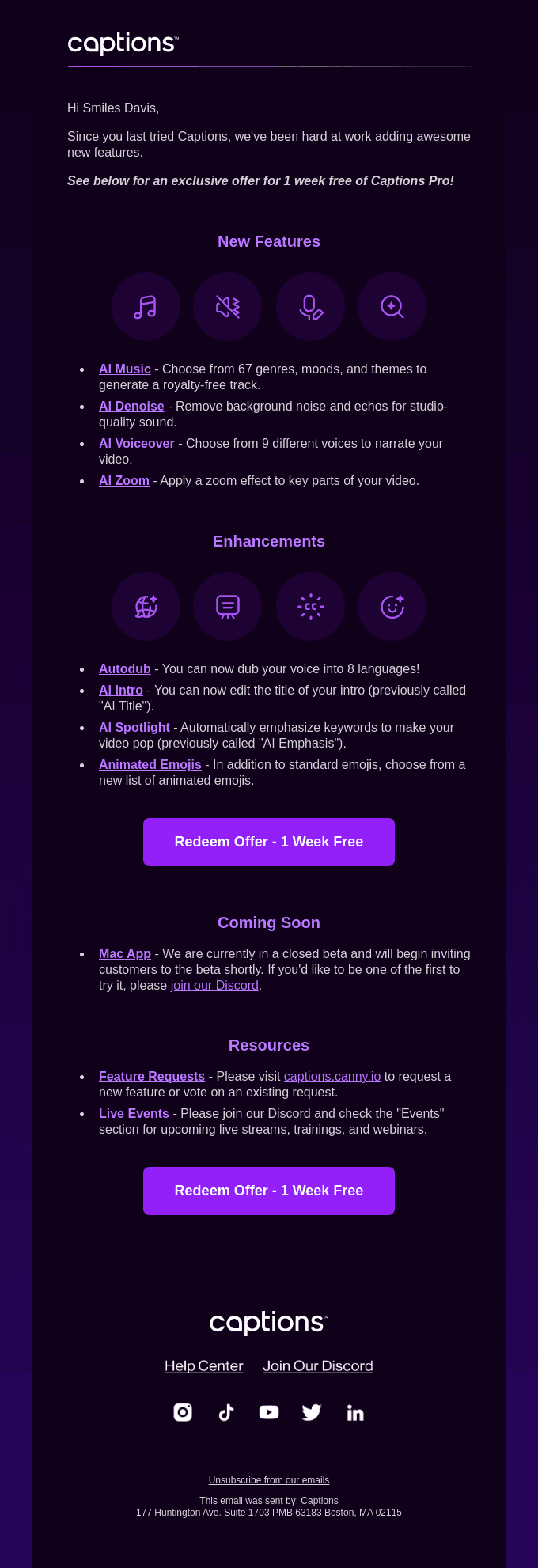
If your inactive customer or subscriber has not been engaging with regular product update emails they’ve received, change tact by switching up the subject line, lead update, images, and messaging, or start with a different content type and lead into this if they continue to engage.
2. Offer incentives such as discounts
In cases where your lost customer has indicated price is the leading factor, an incentive or offer could be enough to bring them back into the fold long enough for them to experience value realization and justify the cost. If you’ve lost them to a competitor or simply waning interest, an enticing offer is a reason to reach out and re-engage.
Take this example from YouTube Premium. The offer is enticing, with a full $50 off NFL Sunday Ticket and the CTA is clear and noticeable. In an email like this, you would want to ensure you are only sending this offer to the segment of your audience that has expressed interest in the NFL or live sports. Otherwise, you risk more inactivity from subscribers who are not interested in watching sports.

If the offer is not taken up, resist the urge to continuously up the discount and send offer after offer as this will erode your brand perception, and customers who do sign up will be less likely to stick around.
3. Offer social proof
Proof of concept from happy customers can go a long way to remind lapsed customers why they were interested in your product in the first place and convince them to take the plunge and make a purchase or subscribe.
Take this email from Calibrate. It includes highly convincing data points, a downloadable report, and customer testimonials in an email that very clearly shows why this program is better than others. Using different proof points — data ‘headlines’, in-depth data, and quotes — helps make a convincing case and appeals to different people and different parts of our brain.

4. Address the problem head-on
Sometimes addressing your customers’ lack of engagement head-on is enough to bring your brand back to the top of their minds and convince them to reengage.
This example from Duolingo uses their signature humor in a win-back email that reminds the user why they signed up in the first place (to learn Japanese). The CTA to ‘Take a 5-minute lesson now’ gives the user a very clear and doable step forward, and it’s all backed up by a study. For a short, sharp email, it packs a punch.
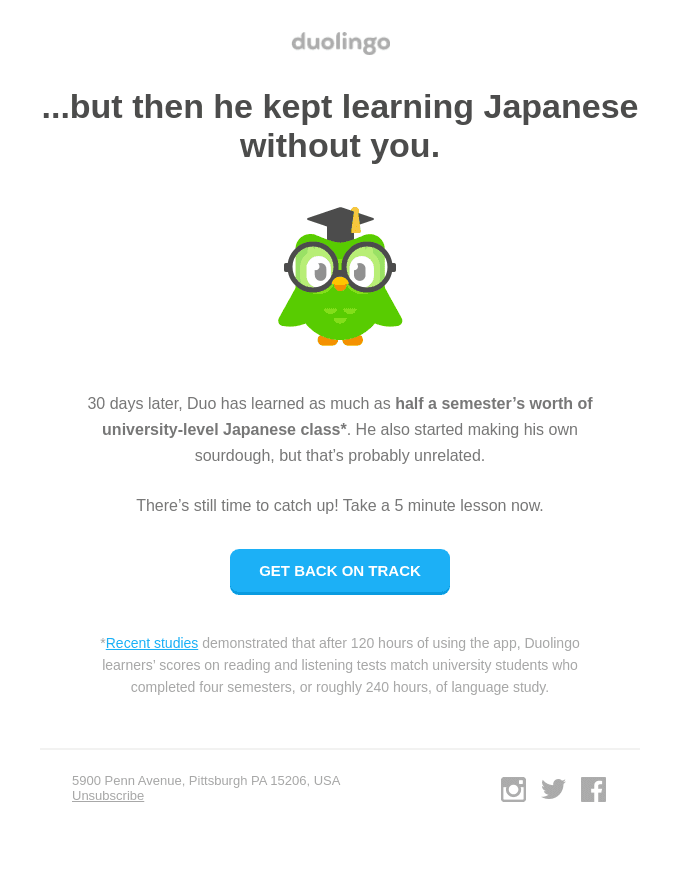
5. Ask them to set their own boundaries
Asking your customer or subscriber whether they want to unsubscribe completely, receive fewer emails, or receive only specific emails can be particularly effective for subscribers who have been unengaged for 9-12 months or as a later email in your win-back sequence.
As Ortto’s Head of Email Deliverability Travis Hazlewood puts it, this kind of email should be “treated like a last-ditch effort to rekindle a long-lost friendship by allowing them to set boundaries for the future”
This example from Cuisinart gives subscribers two clear options, with more detail available in the preference center.
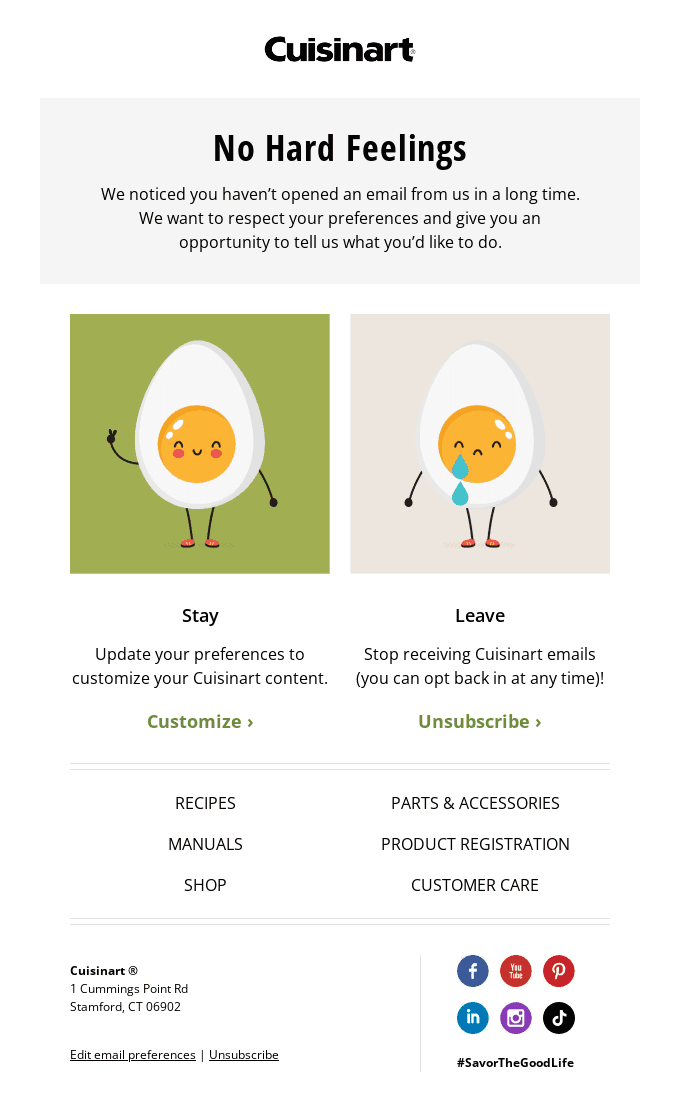
Final word
Remember that customers who have fallen by the wayside aren’t gone forever. With an effective win-back email campaign, you can return them to the fold much faster, easier, and cheaper than acquiring new customers to replace them.
If some customers remain unengaged, your email deliverability will be better off if you simply sunset them and move on. This blog will help you navigate the process.


